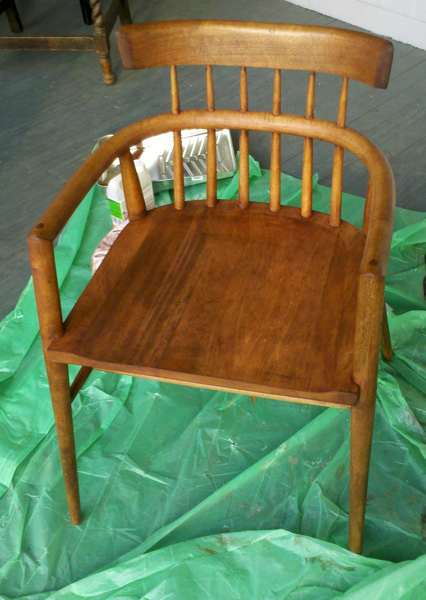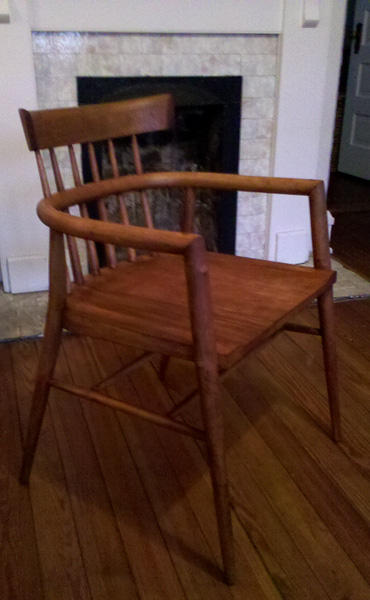 My mom asked me if we needed anything around the house. I said we’d been looking for a mid-century chair or two. Coincidentally, she had one in her shop. She had spotted a guy tossing this chair out. Nice lines, in good shape, but someone had painted a dark, faux woodgrain over the thing. She took it home with the intent of refinishing it, but gave it to me instead.
My mom asked me if we needed anything around the house. I said we’d been looking for a mid-century chair or two. Coincidentally, she had one in her shop. She had spotted a guy tossing this chair out. Nice lines, in good shape, but someone had painted a dark, faux woodgrain over the thing. She took it home with the intent of refinishing it, but gave it to me instead.
I’d never done a chemical stripping, but mom gave me a jug of Citristrip, a mild stripper that smells like oranges. I got to work.
I had to go through probably 5 rounds of the stuff. Apply, wait a bit, then scrape it off. The instructions said to use those green brillo pads and a plastic paint scraper. The scraper did great on the flat surfaces but the dowels and other round surfaces required other methods. The green scrubber pads didn’t do a good job either. After my third round, I went to the hardware store and got a scrubbing brush with stiff, plastic bristles. That and a garden hose seemed to do a better job. Another couple of rounds and it was down to bare wood, with paint remaining in some of the deeper scratches.
 A few rounds with an orbital sander and some sanding sponges got most of the scratches and paint off. I couldn’t do too much without screwing up the lines of the chair, and I couldn’t do much on the round surfaces either, but it looked a lot better without the paint.
A few rounds with an orbital sander and some sanding sponges got most of the scratches and paint off. I couldn’t do too much without screwing up the lines of the chair, and I couldn’t do much on the round surfaces either, but it looked a lot better without the paint.
 The results were so pale that I wasn’t sure what stain would look good on the thing. My first attempt was Minwax Colonial Maple–hated it. A bit too orange on this particular wood (whatever it is), and not dark enough to cover the scratches and other imperfections in the thing. I didn’t want to make it more orange, so I stopped at one coat and changed directions.
The results were so pale that I wasn’t sure what stain would look good on the thing. My first attempt was Minwax Colonial Maple–hated it. A bit too orange on this particular wood (whatever it is), and not dark enough to cover the scratches and other imperfections in the thing. I didn’t want to make it more orange, so I stopped at one coat and changed directions.
 Next – Red Oak. Even the first coat looked better. I did a couple more coats, getting it dark enough to hide some of the flaws but not so dark that the grain got lost.
Next – Red Oak. Even the first coat looked better. I did a couple more coats, getting it dark enough to hide some of the flaws but not so dark that the grain got lost.
A coat of beeswax polish and it looks great!
